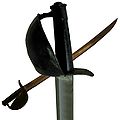Sabre
Sabre is a type of sword that has a curved blade associated with the light cavalry of the Early Modern and Napoleonic periods. Originally associated with Central-European cavalry such as the hussars, the sabre became widespread in Western Europe during the Thirty Years' War. Lighter sabres also became popular with infantry of the early 19th century.
History[edit]
The origins of the sabre are somewhat unclear, and it may come from a variety of Middle Eastern swords such as the scimitar. The military sabre was used as a duelling weapon in war during the 17th and 18th centuries, and as a training weapon in the 19th and 20th centuries. This type of sabre, the duelling sabre, was used to settle disputes between gentlemen.
Design[edit]
The sabre is a single-edged sword, which means it has one sharp edge. The other edge, called the back edge, is usually blunt. The blade is typically curved, and the point is aligned with the hilt. The hilt often includes a hand guard.
Use[edit]
The sabre is primarily used for cutting, but can also be used for thrusting. A typical military sabre is a one-handed weapon, although two-handed versions exist.
Modern Sabre Fencing[edit]
In modern times, the sabre is used in the sport of fencing. The rules for sabre fencing are different from those for foil fencing and épée fencing. In sabre fencing, the entire body above the waist, except the weapon hand, is a valid target.
See Also[edit]
Sabre[edit]
-
Rose Contract of 1812 Cavalry Saber
-
Joanovitch Paul (1859–1957) The Sword Dance, Private Collection
-
Mzwdr XXXX ml 008
-
Thomas Lawrence, Charles William (Vane-)Stewart, Later 3rd Marquess of Londonderry, 1812, oil on canvas, National Portrait Gallery, London
-
Sabre mg 0644-retouched
-
French Navy sabre img 3012b
-
Marxauch Sword
Ad. Transform your life with W8MD's Budget GLP-1 injections from $75


W8MD offers a medical weight loss program to lose weight in Philadelphia. Our physician-supervised medical weight loss provides:
- Weight loss injections in NYC (generic and brand names):
- Zepbound / Mounjaro, Wegovy / Ozempic, Saxenda
- Most insurances accepted or discounted self-pay rates. We will obtain insurance prior authorizations if needed.
- Generic GLP1 weight loss injections from $75 for the starting dose.
- Also offer prescription weight loss medications including Phentermine, Qsymia, Diethylpropion, Contrave etc.
NYC weight loss doctor appointmentsNYC weight loss doctor appointments
Start your NYC weight loss journey today at our NYC medical weight loss and Philadelphia medical weight loss clinics.
- Call 718-946-5500 to lose weight in NYC or for medical weight loss in Philadelphia 215-676-2334.
- Tags:NYC medical weight loss, Philadelphia lose weight Zepbound NYC, Budget GLP1 weight loss injections, Wegovy Philadelphia, Wegovy NYC, Philadelphia medical weight loss, Brookly weight loss and Wegovy NYC
|
WikiMD's Wellness Encyclopedia |
| Let Food Be Thy Medicine Medicine Thy Food - Hippocrates |
Medical Disclaimer: WikiMD is not a substitute for professional medical advice. The information on WikiMD is provided as an information resource only, may be incorrect, outdated or misleading, and is not to be used or relied on for any diagnostic or treatment purposes. Please consult your health care provider before making any healthcare decisions or for guidance about a specific medical condition. WikiMD expressly disclaims responsibility, and shall have no liability, for any damages, loss, injury, or liability whatsoever suffered as a result of your reliance on the information contained in this site. By visiting this site you agree to the foregoing terms and conditions, which may from time to time be changed or supplemented by WikiMD. If you do not agree to the foregoing terms and conditions, you should not enter or use this site. See full disclaimer.
Credits:Most images are courtesy of Wikimedia commons, and templates, categories Wikipedia, licensed under CC BY SA or similar.
Translate this page: - East Asian
中文,
日本,
한국어,
South Asian
हिन्दी,
தமிழ்,
తెలుగు,
Urdu,
ಕನ್ನಡ,
Southeast Asian
Indonesian,
Vietnamese,
Thai,
မြန်မာဘာသာ,
বাংলা
European
español,
Deutsch,
français,
Greek,
português do Brasil,
polski,
română,
русский,
Nederlands,
norsk,
svenska,
suomi,
Italian
Middle Eastern & African
عربى,
Turkish,
Persian,
Hebrew,
Afrikaans,
isiZulu,
Kiswahili,
Other
Bulgarian,
Hungarian,
Czech,
Swedish,
മലയാളം,
मराठी,
ਪੰਜਾਬੀ,
ગુજરાતી,
Portuguese,
Ukrainian





